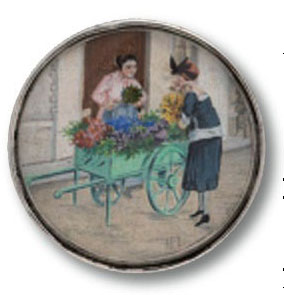AFP
Jun 18, 2010
History sewn up in buttons
AFP
Jun 18, 2010
PARIS, June 18, 2010 (AFP) - Buttons were an invention waiting to happen. Since the dawn of time when early man draped himself in animal pelts, he has needed a way of opening and closing his clothing. An exhibition in Paris pays tribute to this often unconsidered but essential item, showcasing around 1,500 of the rarest and most beautiful buttons amassed by French collector Loic Allio over 20 years.
 From left to right: Ceramic, metal button from the 1940s by François Hugo for Elsa Schiaparelli. Button with pearls on metal from the 1960s by Roger Jean Pierre for Yves Saint Laurent. Bronze button from the 1930s by Alberto Giacometti for Elsa Schiaparelli. All photos © EG Atelier |
Nobody knows when the first button emerged, but it was probably a piece of bone or shell, attached by string. Prehistoric buttons have been found in Egypt, Iran and Greece.
The earliest examples in the show include Chinese buttons in agate from the Han tombs dating back to the Dian kingdom (206 BC to 220 AD). Buttons tend to survive long after the fabric they were sewn onto has rotted away.
The golden age of the button was in 18th century France, when they adorned redingotes and waistcoats. At the time of the French Revolution 1,000 workers were employed in the button industry.
The best buttons were exquisite miniature works of art, such as black and white or hand-tinted engravings, covered in glass and encased in metal circles.
 |
Some were commemorative. The show has examples marking events as diverse as the first hot air balloon flight by the Mongolfier brothers in 1780, George Washington's investiture, the abolition of slavery, and the storming of the Bastille in Wedgwood-style blue and white porcelain.
It also has a few of the 18th century's answer to pornography: buttons with erotic drawings which "libertines" wore concealed behind their lapels or inside their collars.
By the 19th century production became more industrialised, with the use of transfers replacing handpainted porcelain, although fine materials such as horn, tortoiseshell, silver, copper and ivory were still commonplace.
Buttons also reflected the main artistic movements of the day -- Art Nouveau in the 1890s and Art Deco in the 1920s, when early plastics suddenly became fashionable.
The emergence of haute couture at the end of the 19th century created a big demand for unique, one-off buttons. In its heyday between the 1930s and 1950s there were more than 80 couture fashion houses in Paris, putting out four collections a year, providing work for 15 specialist suppliers, who also made belt buckles and hat pins.
Among the big names, now forgotten, were the writer Victor Hugo's grandson Francois Hugo, who was a friend of Jean Cocteau, Max Ernst, Jean Arp and Pablo Picasso, and Henri Hamm, whose circle included the poet Guillaume Apollinaire and artists Amadeo Modigliani and Henri Douanier Rousseau.
Hugo and Hamm created exclusive buttons for the great couturiers, the likes of Worth, Poiret, Doucet and Elsa Schiaparelli, of which the exhibition has a fabulous selection.
The show is being staged by the Mona Bismarck Foundation on the Avenue New York, overlooking the Eiffel Tower. A chance to see the former Paris home of the late American socialite and beauty alone is worth the detour.
The exhibition is open until August 14.by Sarah Shard
Copyright © 2024 AFP. All rights reserved. All information displayed in this section (dispatches, photographs, logos) are protected by intellectual property rights owned by Agence France-Presse. As a consequence you may not copy, reproduce, modify, transmit, publish, display or in any way commercially exploit any of the contents of this section without the prior written consent of Agence France-Presses.

























